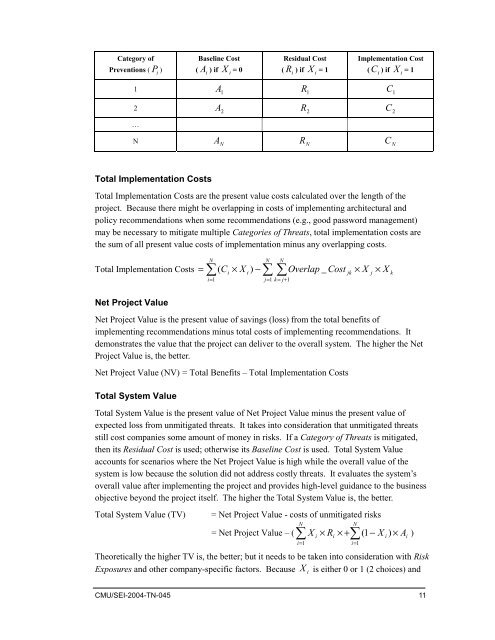SQUARE Project: Cost/Benefit Analysis Framework for Information ...
SQUARE Project: Cost/Benefit Analysis Framework for Information ...
SQUARE Project: Cost/Benefit Analysis Framework for Information ...
Create successful ePaper yourself
Turn your PDF publications into a flip-book with our unique Google optimized e-Paper software.
Category of<br />
Preventions ( P )<br />
i<br />
Baseline <strong>Cost</strong><br />
A ) if X = 0<br />
(<br />
i<br />
i<br />
Residual <strong>Cost</strong><br />
R ) if X = 1<br />
(<br />
i<br />
i<br />
Implementation <strong>Cost</strong><br />
C ) if X = 1<br />
(<br />
i<br />
i<br />
1 A<br />
1<br />
R<br />
1<br />
C<br />
1<br />
2 A<br />
2<br />
R<br />
2<br />
C<br />
2<br />
…<br />
N<br />
A<br />
N<br />
R<br />
N<br />
C<br />
N<br />
Total Implementation <strong>Cost</strong>s<br />
Total Implementation <strong>Cost</strong>s are the present value costs calculated over the length of the<br />
project. Because there might be overlapping in costs of implementing architectural and<br />
policy recommendations when some recommendations (e.g., good password management)<br />
may be necessary to mitigate multiple Categories of Threats, total implementation costs are<br />
the sum of all present value costs of implementation minus any overlapping costs.<br />
Total Implementation <strong>Cost</strong>s<br />
N<br />
= ∑ ∑∑<br />
i i<br />
i= 1<br />
j= 1 k=<br />
j+<br />
1<br />
N<br />
N<br />
( C × X ) − Overlap _ <strong>Cost</strong> × X × X<br />
jk<br />
j<br />
k<br />
Net <strong>Project</strong> Value<br />
Net <strong>Project</strong> Value is the present value of savings (loss) from the total benefits of<br />
implementing recommendations minus total costs of implementing recommendations. It<br />
demonstrates the value that the project can deliver to the overall system. The higher the Net<br />
<strong>Project</strong> Value is, the better.<br />
Net <strong>Project</strong> Value (NV) = Total <strong>Benefit</strong>s – Total Implementation <strong>Cost</strong>s<br />
Total System Value<br />
Total System Value is the present value of Net <strong>Project</strong> Value minus the present value of<br />
expected loss from unmitigated threats. It takes into consideration that unmitigated threats<br />
still cost companies some amount of money in risks. If a Category of Threats is mitigated,<br />
then its Residual <strong>Cost</strong> is used; otherwise its Baseline <strong>Cost</strong> is used. Total System Value<br />
accounts <strong>for</strong> scenarios where the Net <strong>Project</strong> Value is high while the overall value of the<br />
system is low because the solution did not address costly threats. It evaluates the system’s<br />
overall value after implementing the project and provides high-level guidance to the business<br />
objective beyond the project itself. The higher the Total System Value is, the better.<br />
Total System Value (TV)<br />
= Net <strong>Project</strong> Value - costs of unmitigated risks<br />
N<br />
N<br />
= Net <strong>Project</strong> Value – ( ∑ X<br />
i<br />
× Ri<br />
× + ∑( 1−<br />
X<br />
i<br />
) × Ai<br />
)<br />
Theoretically the higher TV is, the better; but it needs to be taken into consideration with Risk<br />
Exposures and other company-specific factors. Because X is either 0 or 1 (2 choices) and<br />
i=<br />
1<br />
i<br />
i=<br />
1<br />
CMU/SEI-2004-TN-045 11
















